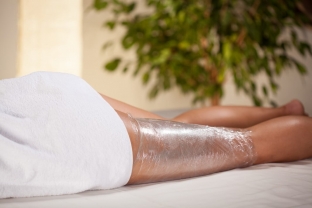The wrapping procedure is primarily a therapeutic measure, since the active substances from the mask applied to the body penetrate deep into the dermal layers of the skin and stimulate the production of hyaluronic acid, collagen fibers, promote the breakdown of fat deposits and the removal of excess fluid from the body. As a result of wraps, skin elasticity and moisture increase, cellulite manifestations decrease, and the silhouette is tightened. A pleasant bonus of the wrapping procedure is the use of fragrant compositions for its implementation, which allow you to relax and enjoy the procedure.
The essence of the wrapping procedure, recommendations and contraindications
The wrapping procedure consists in applying a special composition to the whole body or its individual problem areas, the active ingredients of which are selected depending on the skin problem to be solved. Then a thermal effect is made on the body, due to which the active components of the applied mask penetrate deep into the layers of the skin. Wrapping procedures can be an important part of a package of measures designed to solve the following problems:
- overweight, cellulite, fat traps;
- flabbiness of the skin;
- dryness and flaking of the skin;
- stress, some neurological diseases.
Like any cosmetic manipulation, the wrapping procedure has its own contraindications. These include:
- fungal skin lesions;
- any recent skin injury - wounds, abrasions, scratches, stitches and scars;
- exacerbations of dermatological diseases;
- acute infectious diseases;
- chronic heart disease, diabetes mellitus;
- fibroma, polycystic;
- menstruation;
- arterial hypertension;
- pregnancy.
Types of possible wraps and their main features
The wrapping procedure can be carried out in three forms - hot, cold and contrast.
The hot wrapping procedure consists in the fact that after applying a special mask to the body, a thermal effect is created using a film, infrared radiation or a thermal blanket. The body warms up to a temperature of approximately 38-40°C, while metabolic processes are activated, and the substances from the mask are actively absorbed into the skin. Such wraps are effective in areas with dense adipose tissue, but are contraindicated in thrombophlebitis and varicose veins.

Cold wraps involve the use of a body mask chilled to 20-22°C, the cooling effect is enhanced by the addition of menthol to the mask. Such wrapping procedures narrow capillaries, reduce puffiness, tone up, increase skin elasticity. Cold packs are especially effective for loose skin.
Contrast wrapping procedures are effective on those areas where there are local fat deposits, cellulite. Alternate application of hot and cold wraps leads to active splitting and removal of fat, increasing skin elasticity in the treated areas.
For the wrapping procedure, compositions are selected in which the source of active components can be algae, honey, vegetable oils, honey, therapeutic mud and clay. Before the wrapping procedure, peeling is necessary to deeply cleanse the skin and increase its ability to perceive the active components of the wrap. After the procedure, a cosmetic product is applied to the skin to fix the results.








Add a comment